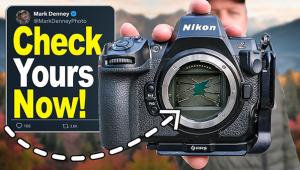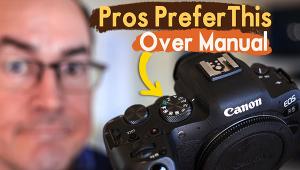What’s Ahead For Digital Cameras?
New Technology Changes The Game
Photography is a wide-ranging field that engenders passion in its practitioners,
and like all great forms of expression creates opinions formed through experience
and reflection. In its early days one of the great debates was: Is Photography
Art? This was the subject of many essays and heated discussions among players
and spectators. Today, issues such as film vs. digital, format choices, the
validity of computer generated images, photography as exploitation or revealer,
and even the merits of ink jet vs. silver prints cause similar debate. We are
opening this department up to readers, manufacturers, and retailers--in
short, everyone who lives and breathes photography and who has an opinion about
anything affecting imaging today.
Here's how to get involved: write us an e-mail at editorial@shutterbug.com
or send us a letter with a proposed topic and a synopsis of your idea. Once
approved, we'll ask you to send us about 500-1000 words on the subject
chosen. The idea here is not to push any product or wave any flag, but to create
discussion about photo and imaging topics of the day. We reserve the right to
edit whatever you send in, although we will never edit intention or opinion
but only for length and, hopefully, for clarity. We reserve the right to publish
your work on our website as well, so you can join the archives and be a resource
for opinion for years to come.
So, get thinking and writing and share your Point of View.
--George Schaub
As competition heats up and manufacturing efficiencies are realized, most baseline
models in the $149-$249 range will be offered with 3 megapixels and a minimum
of a 3x optical zoom. Those specs alone will get you 4x6 prints comparable with
most point-and-shoot film camera prints. Viewing screens will change, too, with
2-3" LCD screens emerging as the new minimum standard. These larger screens
will make in camera photo-editing composition a lot easier and will improve
user friendliness, especially when it comes to shooting video. On the battery
scene you'll see more models with rechargeable batteries. Better yet,
those batteries will shoot more pictures because manufacturers are using low-powered
processors and other critical power management components.
Shutter lag, that annoying delay from the time you click the shutter until the
time the camera responds is dramatically decreasing. In fact, digital camera
shutter lag time is now approaching the lag time for point-and-shoot film cameras.
Shot-to-shot delay is also decreasing, allowing digital shooters to more comfortably
keep up with the action.
The big change in memory cards is that the cost per megabyte keeps falling.
A 512MB CompactFlash card holds about the same number of pictures as 14 rolls
of film. With that card retailing for less than $40 right now, you're
already at the same cost as the 14 rolls. If the downward price trend continues,
one does not even to have erase the memory card for reuse anymore.
Take a step up from the entry-level models and that's where the race really
heats up. At the mid ($299) through upper ($1000) price points, we'll
be seeing significant advances in three main areas: 1) image capture, 2) advanced
control, including in camera photo-editing features, and 3) improved downloading
and sharing techniques.
In megapixels, we'll continue to see incremental upswings in the 6-, 7-,
and 8-megapixel range and beyond. But the impact of increased megapixel counts
on image quality will be minor compared to the new advancements in image capture
and in camera photo editing. Starting in 2005 you'll see manufacturers
using high-tech solutions to solve age-old problems like camera shake, contrast
extremes, optical aberrations, and redeye. Other in camera editing options will
allow photographers to get more creative right in the camera, without the need
for PC-based photo-editing programs.
Image Stabilization
Camera shake is not unique to digital. It's been with us since the early
days of film. But, with the least expensive digital cameras now offering a 3x
optical zoom and higher-end cameras at the 10-12x level, a steady hand might
be too much to ask. A 10x optical zoom might offer the equivalent of a 350mm
telephoto on a 35mm camera, and there aren't many photographers who can
hand hold that focal length and get consistently shake-free images. So, you'll
be seeing Image Stabilization in many of the new digital cameras. This year
only a few manufacturers have it. Within five years, all manufacturers will
be offering this important feature.
There are several different Image Stabilization techniques. What they have in
common is that they all rely on a powerful digital processor and software to
track camera movement. On the high-end models, the digital processor analyzes
the camera movement and determines how fast, how much, and in which direction
it has to physically move either the lens or the image capture sensor to eliminate
blur. On mid-priced models, the image tracking process is the same, but instead
of physically moving the lens or imaging sensor, the processor applies corrective
software fixes to the image itself to digitally sharpen the blur. At the lowest
end of the price range, the camera will employ similar tracking techniques,
but rather than order a mechanical or digital correction, it will simply prevent
you from shooting a picture that it knows will be blurry. That will force you
to steady the camera or zoom out a bit.
Because of the higher megapixel counts in all digital still cameras, manufacturers
will also offer dramatically higher-quality video capabilities. This year you
can expect to see VGA quality resolution (640x480) with frame rates of 30 frames
per second as a standard feature in many models. Add video stabilization to
the mix and for the first time you've got a real video camera packaged
inside a digital still camera.
- Log in or register to post comments

































